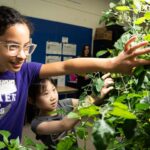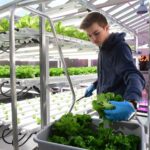The Empowering Greenhouse Resiliency with an Optimized Workforce (E-GROW) project team has completed its first objective by identifying gaps in U.S. greenhouse education programs in 2025.
Read the Gaps in CEA Education report here.
While some programs, such as New York Sun Works, Virginia’s GO TEC, and Pennsylvania’s AgWorks have introduced CEA and AgTech concepts into classrooms through courses for credit and workforce pathway programs (WPP), efforts remain fragmented, teacher-dependent, and geographically uneven. In rural areas, barriers include a lack of certified educators, limited access to resources like funding for on-campus infrastructure or tools, and the absence of standardized curricula and certification programs to prepare youth for CEA and AgTech careers. In some cases, educators must create their own materials with little centralized support or coordination.
The next objective for the E-GROW team is to develop CEA Education Solutions most needed by pilot schools in New York, Pennsylvania, Virginia, and Wyoming in 2026.
“The E-GROW courses and tools we are developing will democratize access to the knowledge, skills, and abilities needed for careers in the CEA industry,” shares Gretchen Schimelpfenig, Executive Director of Cornell University’s GLASE consortium.
About E-GROW
The Empowering Greenhouse Resiliency with an Optimized Workforce (E-GROW) project is developing youth interest and competency in agricultural technology (AgTech) for food production in controlled environment agriculture (CEA) by creating non-formal agricultural educational content and activities to foster curiosity and competency of tech-savvy STEM students in disciplines like automation of vegetable greenhouse climate control systems, robotics and AI for crop science, and energy and economic benchmarking of vertical farms. E-GROW will pilot a CEA certificate for youth at ten middle and high schools in New York, Pennsylvania, Virginia, and Wyoming for integration into a future CEA workforce credentialing program. E-GROW pilots expect to reach 500-1,000 youth and reach student populations underrepresented in STEM including rural youth, students from low-income households, young women, ethnic minorities, and persons with disabilities. Seven project partners from higher education and youth development will collaborate to accomplish the aims with assistance from a mentoring network of industry professionals, academics, and researchers facilitating and amplifying accomplishments of students. Progress toward four distinct aims with milestones over four years will be evaluated by an Advisory Group of pilot school stakeholders. E-GROW non-formal educational modules, experiential learning activities, and modeling tools tailored for grades 6-12 will build on existing youth development strategies to increase understanding of the benefits of CEA AgTech. Student-produced capstone projects and outreach materials will demonstrate competency and build public confidence in AgTech in food systems by showing their communities how AgTech enables CEA operations to produce fresh food and support local jobs. Learn more about the project at https://glase.org/about-glase/e-grow.





